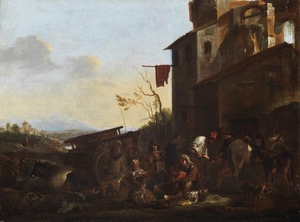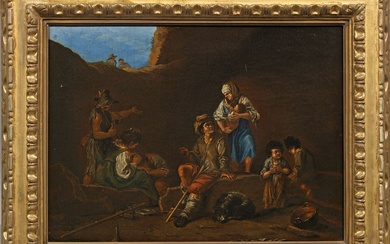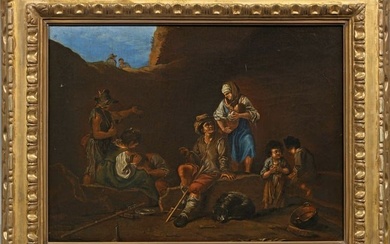JAN MIEL The blacksmith
The blacksmith's shop. . Oil on canvas . Cm 68,00 x 50,50. The painting is accompanied by a card by Arabella Cifani. The painting is a characteristic scene of Roman "bambocciata". Depicting a blacksmith shoeing a horse surrounded by characters who observe it, in the foreground a "picnic" of populace next a cart with animals. On the right a Roman farmhouse in which you can recognize ancient remains embedded by the building, with a red rag indicating the presence of an inn. The artwork, both for the cutting of the scene and for the layout of the composition, is part of the typical production of the Flemish painter Jan Miel, master of the genre of the bambocciata, who, inspired by the founder of the genre, Pieter Van Iaer said the child, painted rural and popular scenes, set in urban glimpses in part of fantasy or picturesque scenes of the vast Roman countryside, perhaps dotted with ruins and other ancient elements. But always present in his paintings a tasty and lively attention to the realistic datum. Compared to Van Iaer's production, Miel enriched his canvases with many anecdotal and descriptive details. Miel was born in Beveren-Waas (Anversa) in 1599 and died in Turin in 1664. After a first training at home, perhaps at the workshop of Gerard Seghers and then Anton Van Dyck, the painter was documented in Rome from 1636, where in 1648 he joined the Academy of San Luca, of which he became Prior in 1661. The update on Correggio painting and then the collaboration with Andrea Sacchi lead him towards a personal interpretation of classicism and open the way for the important Roman commissions. After the frescoes, lost, in Santa Teresa at the waterfront painted for the Barbierini, painting for the churches of San Martino ai Monti, Santa Maria dell'Anima and San Lorenzo in lucina and participates, with influences from Cortona, to the important decorative enterprise of the Gallery of Pope Alexander VII Chigi in the Palazzo del Quirinale. To the production of cultured painter of history, however, alongside that of the most famous "bambocciate", often confused with those of Pieter Van laer and Michelangelo Cerquozzi, collaborating also with architectures painters such as Alessandro Salucci and viviano codazzi. At the end of 1658 the miel was called to Turin by Duke Carlo Emanuele II, who greatly appreciated his painting. For Piedmont he had in fact painted since 1651, the Madonna that presents the Child and Saint Anthony of Padua of the Duomo di chieri. Thanks to the prestigious Roman credentials he was commissioned to fresco the vault of Diana’s hall in the Reggia di venaria (1661-1663) and to provide for the walls the canvas with the equestrian portrait of Adelaide and Ferdinando Maria elector of Bavaria and the ten hunts now kept at the Civic Museum of Ancient Art of Palazzo Madama in Turin. The Doge’s commission also concerns the City Palace, where the miel performs the plafonds of the Throne Room and the Council Hall, already alcove and alcove, as well as numerous superintendents, then removed in the following settings. His sudden and mature death, but not too late, was felt in Turin and particularly saddened the Duke of Savoy. The painting, here studied, belongs to the Roman period of his activity and can easily and convincingly be compared with his well-known paintings. Comparisons could still be many for this work, in which, even in reduced proportions, there is a popular world very articulated and characterized by identical situations. Similar and specular by setting are also a painting of the Louvre and two of the Prado. The numerous comparisons proposed confirm the autography of the canvas and allow it to be placed chronologically around 1640-45: at the time of its fruitful and long Roman stay. Excellent conditions.Bibliography: A. Busiri Vici, Opere di Jan Miel alla corte sabauda, in: "Bollettino della società piemontese di archeologia e di belle arti", 1958-1959, pp. 94-118;A. Griseri, Pittura, in V. Viale (a cura di), Mostra del Barocco piemontese, Torino 1963, vol. II, pp. 62-63;A. Baudi di Vesme, Schede Vesme. L'arte in Piemonte dal XVI al XVIII secolo, Vol. II, Torino 1966, pp. 686-690;A. Griseri, Le metamorfosi del Barocco, Torino 1967, pp. 160-164, 176;Didier Bodart, les peintres des Pays-Bas meridionaux et de la principaute de Liege a Rome au XVIIeme siecle/par Didier Bodart. Institut Historique Belge de Rome, Bruxelles, Institut historique belge de Rome, 1970, ad indicem;M. di Macco, C. Spantigati e G. Romano, La Venaria Reale: un libro e un'impresa decorativa, in B. Bertini Casadio e I. Massabò Ricci (a cura di), I rami incisi dell'Archivio di Corte: sovrani, battaglie, architetture, topografie, catalogo della mostra, Torino 1981, pp. 321-339;L. Trezzani, Jan Miel, in G. Briganti, L.Trezzani, L. Laureati, I bamboccianti. Pittori della vita quotidiana a Roma nel Seicento, Roma 1983, pp. 91-131;M. di Macco, Quadreria di palazzo e pittori di corte. Le scelte ducali dal 1630 al 1684, in G. Romano (a cura di), Figure del Barocco. La corte, la città , i cantieri, le province, Torino 1988, pp. 58, 61,62, 64,66, 67, 72, 130-132, 134, 136;Friso Lammertse, Hannibal's dream: a painting by Jan Miel after an idea by Emanuele Tesauro, in: Journal of the Warburg and Courtauld Institute, London, 52. 1989, pp. 253-256;Arabella Cifani - Franco Monetti, I piaceri e le grazie. Collezionismo, pittura di genere e di paesaggio fra Sei e Settecento in Piemonte, Torino 1993, ad indicem; ivi ulteriore bibliografia.
[ translate ]View it on
Sale price
Estimate
Time, Location
Auction House
The blacksmith's shop. . Oil on canvas . Cm 68,00 x 50,50. The painting is accompanied by a card by Arabella Cifani. The painting is a characteristic scene of Roman "bambocciata". Depicting a blacksmith shoeing a horse surrounded by characters who observe it, in the foreground a "picnic" of populace next a cart with animals. On the right a Roman farmhouse in which you can recognize ancient remains embedded by the building, with a red rag indicating the presence of an inn. The artwork, both for the cutting of the scene and for the layout of the composition, is part of the typical production of the Flemish painter Jan Miel, master of the genre of the bambocciata, who, inspired by the founder of the genre, Pieter Van Iaer said the child, painted rural and popular scenes, set in urban glimpses in part of fantasy or picturesque scenes of the vast Roman countryside, perhaps dotted with ruins and other ancient elements. But always present in his paintings a tasty and lively attention to the realistic datum. Compared to Van Iaer's production, Miel enriched his canvases with many anecdotal and descriptive details. Miel was born in Beveren-Waas (Anversa) in 1599 and died in Turin in 1664. After a first training at home, perhaps at the workshop of Gerard Seghers and then Anton Van Dyck, the painter was documented in Rome from 1636, where in 1648 he joined the Academy of San Luca, of which he became Prior in 1661. The update on Correggio painting and then the collaboration with Andrea Sacchi lead him towards a personal interpretation of classicism and open the way for the important Roman commissions. After the frescoes, lost, in Santa Teresa at the waterfront painted for the Barbierini, painting for the churches of San Martino ai Monti, Santa Maria dell'Anima and San Lorenzo in lucina and participates, with influences from Cortona, to the important decorative enterprise of the Gallery of Pope Alexander VII Chigi in the Palazzo del Quirinale. To the production of cultured painter of history, however, alongside that of the most famous "bambocciate", often confused with those of Pieter Van laer and Michelangelo Cerquozzi, collaborating also with architectures painters such as Alessandro Salucci and viviano codazzi. At the end of 1658 the miel was called to Turin by Duke Carlo Emanuele II, who greatly appreciated his painting. For Piedmont he had in fact painted since 1651, the Madonna that presents the Child and Saint Anthony of Padua of the Duomo di chieri. Thanks to the prestigious Roman credentials he was commissioned to fresco the vault of Diana’s hall in the Reggia di venaria (1661-1663) and to provide for the walls the canvas with the equestrian portrait of Adelaide and Ferdinando Maria elector of Bavaria and the ten hunts now kept at the Civic Museum of Ancient Art of Palazzo Madama in Turin. The Doge’s commission also concerns the City Palace, where the miel performs the plafonds of the Throne Room and the Council Hall, already alcove and alcove, as well as numerous superintendents, then removed in the following settings. His sudden and mature death, but not too late, was felt in Turin and particularly saddened the Duke of Savoy. The painting, here studied, belongs to the Roman period of his activity and can easily and convincingly be compared with his well-known paintings. Comparisons could still be many for this work, in which, even in reduced proportions, there is a popular world very articulated and characterized by identical situations. Similar and specular by setting are also a painting of the Louvre and two of the Prado. The numerous comparisons proposed confirm the autography of the canvas and allow it to be placed chronologically around 1640-45: at the time of its fruitful and long Roman stay. Excellent conditions.Bibliography: A. Busiri Vici, Opere di Jan Miel alla corte sabauda, in: "Bollettino della società piemontese di archeologia e di belle arti", 1958-1959, pp. 94-118;A. Griseri, Pittura, in V. Viale (a cura di), Mostra del Barocco piemontese, Torino 1963, vol. II, pp. 62-63;A. Baudi di Vesme, Schede Vesme. L'arte in Piemonte dal XVI al XVIII secolo, Vol. II, Torino 1966, pp. 686-690;A. Griseri, Le metamorfosi del Barocco, Torino 1967, pp. 160-164, 176;Didier Bodart, les peintres des Pays-Bas meridionaux et de la principaute de Liege a Rome au XVIIeme siecle/par Didier Bodart. Institut Historique Belge de Rome, Bruxelles, Institut historique belge de Rome, 1970, ad indicem;M. di Macco, C. Spantigati e G. Romano, La Venaria Reale: un libro e un'impresa decorativa, in B. Bertini Casadio e I. Massabò Ricci (a cura di), I rami incisi dell'Archivio di Corte: sovrani, battaglie, architetture, topografie, catalogo della mostra, Torino 1981, pp. 321-339;L. Trezzani, Jan Miel, in G. Briganti, L.Trezzani, L. Laureati, I bamboccianti. Pittori della vita quotidiana a Roma nel Seicento, Roma 1983, pp. 91-131;M. di Macco, Quadreria di palazzo e pittori di corte. Le scelte ducali dal 1630 al 1684, in G. Romano (a cura di), Figure del Barocco. La corte, la città , i cantieri, le province, Torino 1988, pp. 58, 61,62, 64,66, 67, 72, 130-132, 134, 136;Friso Lammertse, Hannibal's dream: a painting by Jan Miel after an idea by Emanuele Tesauro, in: Journal of the Warburg and Courtauld Institute, London, 52. 1989, pp. 253-256;Arabella Cifani - Franco Monetti, I piaceri e le grazie. Collezionismo, pittura di genere e di paesaggio fra Sei e Settecento in Piemonte, Torino 1993, ad indicem; ivi ulteriore bibliografia.
[ translate ]Sale price
Estimate
Time, Location
Auction House
Similar Items

Dutch painting United States Login






